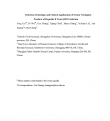Detection Technology and Clinical Applications of Serum Virological Products of Hepatitis B Virus (HBV) Infection
Abstract
Serum virological products of hepatitis B virus (HBV) infection, such as HBV DNA, HBV RNA, hepatitis B surface antigen (HBsAg), hepatitis B e antigen (HBeAg), and hepatitis B core-related antigen (HBcrAg), are important non-invasive indicators that are critical for the rapid diagnosis of the diseases. Improving the accuracy of these products is essential, and the development of corresponding detection technologies is pivotal in achieving this goal. The aim of this article is to provide a comprehensive and systematic overview of the life cycle of HBV, including the latest research progress. In addition, classical and novel methods for detecting HBV serum virological products with high accuracy are analyzed and compared, and their clinical applications are discussed. Ultimately, the goal of this article is to provide valuable insights and references for effectively monitoring chronic hepatitis B (CHB) infection.


